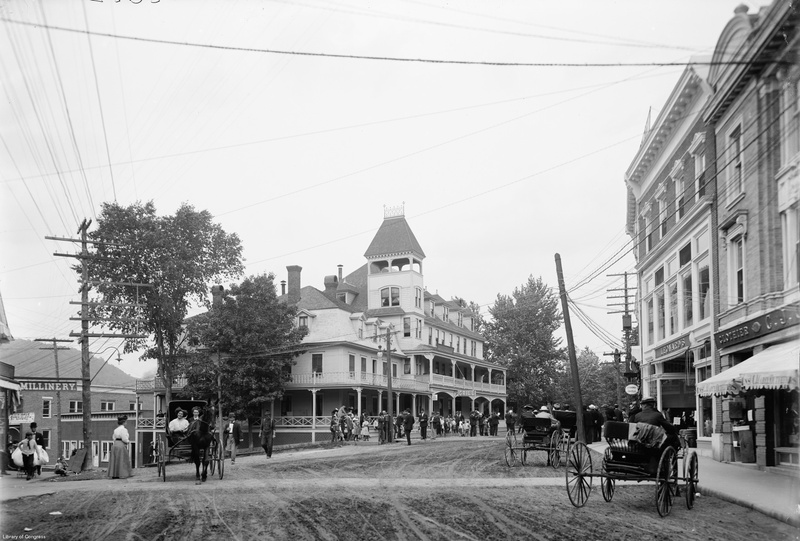 Berkeley House, center. The low, dark building to the left of the Berkeley is at 7-11 Broadway; it was later torn down to make room for the Pontiac Theater. Further left down Broadway, the brick building is the Loomis Block. A small brass band is playing in the middle of Main Street in front of the Berkeley. At far right is the C. J. Carey Company in the Coulter Block; to its left is Leonard's (c. 1909)
Berkeley House, center. The low, dark building to the left of the Berkeley is at 7-11 Broadway; it was later torn down to make room for the Pontiac Theater. Further left down Broadway, the brick building is the Loomis Block. A small brass band is playing in the middle of Main Street in front of the Berkeley. At far right is the C. J. Carey Company in the Coulter Block; to its left is Leonard's (c. 1909) 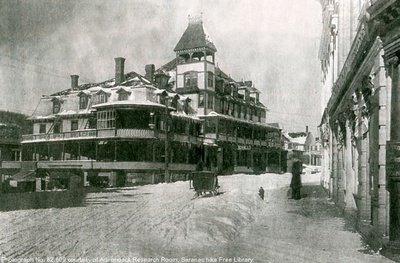 Here, the Berkeley Hotel at the height of its development fills the space that is now Berkeley Green. The wide space in the road where Broadway begins at the curve of Main Street is still called Berkeley Square, while the designation "Riverside Square" - a similar space at the intersection of Main, River and St. Bernard Streets in front of the Riverside Inn - has been lost. Directly behind the blurry figure on the sidewalk at right is a house that occupied the site of the 1960s addition to the Saranac Lake Free Library, and that was used as the headquarters of the Saranac Lake Study and Craft Guild. Far to the right is one dark column that frames the entry of the Coulter Block, once Kollecker's photography shop. This original print is otherwise unidentified. Adirondack Daily Enterprise, February 23, 2013
Here, the Berkeley Hotel at the height of its development fills the space that is now Berkeley Green. The wide space in the road where Broadway begins at the curve of Main Street is still called Berkeley Square, while the designation "Riverside Square" - a similar space at the intersection of Main, River and St. Bernard Streets in front of the Riverside Inn - has been lost. Directly behind the blurry figure on the sidewalk at right is a house that occupied the site of the 1960s addition to the Saranac Lake Free Library, and that was used as the headquarters of the Saranac Lake Study and Craft Guild. Far to the right is one dark column that frames the entry of the Coulter Block, once Kollecker's photography shop. This original print is otherwise unidentified. Adirondack Daily Enterprise, February 23, 2013  Berkeley House - 1890, Adirondack Daily Enterprise, July 12, 2002
Berkeley House - 1890, Adirondack Daily Enterprise, July 12, 2002 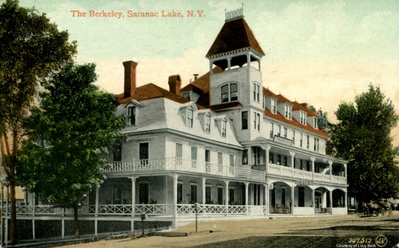 Berkeley House, undated. The original building is to the left of the tower.
Berkeley House, undated. The original building is to the left of the tower.  Berkeley House - 1900
Berkeley House - 1900 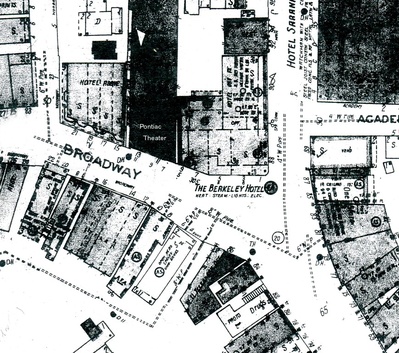 Berkeley Hotel area (1931)
Berkeley Hotel area (1931)  Winter Carnival - 1920
Winter Carnival - 1920
For many years the village erected a Christmas tree in this spot,
a practice discontinued in 1961. Berkeley House Stationery, 1902, Historic Saranac Lake collection. Address: The hotel burned January 10, 1981. The site, at the intersection of Main Street and Broadway, is now a small village park called Berkeley Green.
Berkeley House Stationery, 1902, Historic Saranac Lake collection. Address: The hotel burned January 10, 1981. The site, at the intersection of Main Street and Broadway, is now a small village park called Berkeley Green.
Old Address: 88 and 90 Main Street. Some businesses in the Berkeley had Main Street addresses; others had Broadway addresses ranging from 1 to 9.
Other names: Berkeley Hotel, Berkeley Square
Year built: c. 1875 (Expanded by 1893)
Berkeley House, at Broadway and Main Street, was built in 1875 by Charles F. Gray for the accommodation of tuberculosis patients who were then beginning to come to Saranac Lake for their health. It had a capacity for only fifteen or twenty guests, which was adequate at the time. 1Eugene Woodruff succeeded Gray as proprietor, and in 1882 a Mr. Streeter and his partner Mr. Dennison took it over, enlarged it, and ran it successfully for a number of years. 2 Streeter and Dennison both died, and it was run by Mrs. Dennison until she remarried, after which it had several lessees until it was bought by Walter Sagendorf in 1913, who owned it until 1940.
It was named for Irish philosopher Bishop George Berkeley. 3
U. S. President Benjamin Harrison stayed at the Berkeley in September of 1890 when he was in town to dedicate the new Saranac Lake High School. 4
It was the home of many businesses, including Clinton J. Ayers Insurance and Real Estate in 1948
In 1946, radio station WNBZ moved from the Masonic Temple at 70 Broadway to the Berkeley Hotel, at Broadway and Main Street, where its studio looked out over the center of the village.
The hotel was bought in 1978 by 21 year old John McClain, who sold the Blue Gentian portion of the property to Meta Bofinger the following year, and refurbished the hotel for use by those attending the 1980 Winter Olympics. It burned to the ground, January 10, 1981. It became Berkeley Square park.
Albert Charles Bagdasarian resided at the Berkeley.
Malone Palladium, April 3, 1890.
The Telegram says that D. J. GILLIGAN of Ticonderoga, has leased MILO B. MILLER'S hotel at Saranac lake for five years at $20,000.
From The Adirondacks, Illustrated, p.75, by Seneca Ray Stoddard, 1893—
"The New Berkeley will accommodate 100. Rates $3 to $4 per day' $15 to $21 per week. Open the year round. Streeter & Dennison, proprietors. This house has been noted for some years for its table and as a specially neat place, much too small to accommodate its would-be guests. Now with increased capacity and added conveniences, it is the desirable house of the village. It has steam heat and open fireplaces—both a most satisfactory combination, as it insures warmth with ventilation—electric bells, baths and other modern improvements. A free carriage runs to all trains at the stations."
New York Times, May 26, 1895
THE BERKELEY HOUSE, Saranac Lake, Franklin County, New-York. Streeter & Denison, managers., Open all the year. Accommodates 100 persons. Board, $2.50 to $4 per day; $14 to $25 per week. Ten hours from the Greater New-York. Reached by the New-York Central and Hudson River Railroad and Delaware and Hudson Canal Company Railroad, Via Plattsburg.
The management announces that the Berkeley House new, cheerful, and commodious, is situated upon the highest elevation in Saranac Lake Village. From a sanitary point of view, medical men look upon its location as one especially conducive to dry air and surroundings, and unsurpassed by any other location in the mountains. Every modern improvement is included in the Berkeley—steam heat throughout, electric lights and bells, perfectly ventilated bathrooms, closets, &c. A feature worthy of special notice is the are escapes and well-regulated fire department of the house. As to the convenience of location of the Berkeley, it is only necessary to state that the Post Office is opposite the house, and the Western Union and Postal Telegraph offices, bank, and Opera House are close at hand. Four churches are each within two minutes' walk. Dr. Trudeau's residence and new laboratory are within fifty rods, and the Adirondack Public Library about the same. Mail facilities are excellent, enabling business men to keep in easy and rapid communication with their homes.
Malone Palladium, October 11, 1900
John H. Wilson, assistant manager of the Berkley House at Saranac Lake, one of the best known hotel men in the Adirondack region, died Oct. 2d at Saranac Lake of typhoid fever. He was about 40 years old.
Chateaugay Record, May 16, 1913
The Berkeley hotel has been purchased by Walter Sagendorf, who has made numerous improvements to the property.
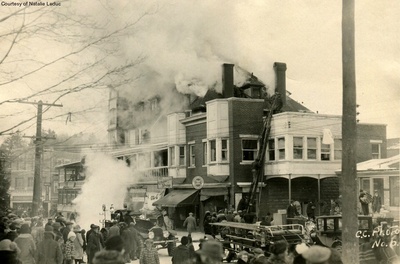 Berkeley House fire, January 1, 1925
Berkeley House fire, January 1, 1925
From the Adirondack Record - Elizabethtown Post, January 8, 1925
BERKELEY HOUSE IS GUTTED BY FIRE New Year's Day Blaze Practically Wipes Out Saranac Lake Tubercular Resort
A New Year's Day fire which started at about 11:30 o'clock Thursday morning, practically wiped out the Berkeley Hotel at Saranac Lake, one of the widely-known landmarks of the Adirondack region. Starting in a chimney the blaze spread rapidly through the wooden building. After breaking through the dry timbers of the roof the flames shot thirty feet into the air and the building was practically doomed when the firemen arrived.
So rapidly did the flames spread that some of the guests were unable to get out of the hotel without aid. Some of them had to be carried out of the burning building into freezing air.
The threatening appearance of the fire caused a call to be sent to Lake Placid for aid and the firemen from the Lake made the run in record time. Although the blaze was checked in twenty minutes and the fire under control in an hour, the damage was heavy and the hotel is practically ruined, the upper floors being consumed and the remainder of the building practically flooded with water.
Among the tenants of the building who suffered heavily from water were Bouck's Bakery, Lee Cheeseman's stationery shop, Harry Schramm's barber shop and the Gertrude Hat Shop. Jacqmor's, Inc., children's shop and Spaulding Sport Shop also suffered considerable damage. It is stated that the damage will reach upwards of $75,000.
With the talk of a new hotel, the Berkeley, which was built in 1877, will probably never be rebuilt. It was built primarily for tubercular patients who found it hard to secure cottage or hotel accommodation. At present it is owned by C. E. Welch.
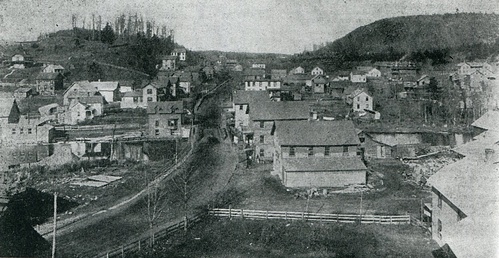 Watertown Daily Times, 1948 Watertown Daily Times, 1948 5
Watertown Daily Times, 1948 Watertown Daily Times, 1948 5
SARANAC LAKE IN 1887 — This photo taken by George Baldwin, pioneer Saranac Lake photographer in 1887, was taken from the top balcony of the Berkeley Hotel. The photo looks up Broadway from Berkeley square.
The building in the right foreground was a workshop connected with the Berkeley Hotel, for a time the top floor of the building was used by an undertaker. No building stands on the site today and a street, Woodruff street, intersects the old site.
Behind the workshop is the building that has become the George L. Starks and Co., building. This picture was taken when the building was used as the original hardware store. Today it is a two story brick building.
The building on the far side of the river, on the left was the first five and ten cent store in the village. Early in the 1900's the building burned to the ground and a charge of arson was made against the owner, though jury failed to indict him.
The vacant space in the foreground is today the site of many of Saranac Lake's thriving businesses and buildings including the Pontiac theatre, the Downing block and the Wilson Clothing company.
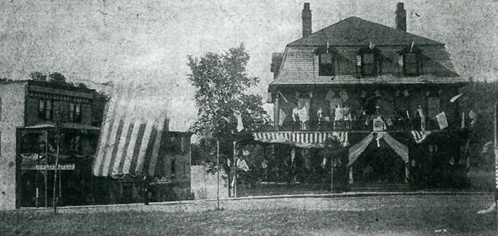 Watertown Daily Times, 1948 Watertown Daily Times, 1948
Watertown Daily Times, 1948 Watertown Daily Times, 1948
AWAITING PRESIDENT HARRISON — Saranac Lake dressed in its best bib and tucker on a warm day in September, 1890, to welcome President Benjamin Harrison to the village. On tour the year after his inauguration, President Harrison stopped off at Saranac Lake and dedicated the second section of the new school building.
In the above picture, which is believed to have been taken by George Baldwin, the camera was set to the left of the speaker's platform, and shows the Berkeley Hotel and several buildings on Main street. Although some have been necessarily altered in the 58 years that have elapsed since this picture was taken, each building pictured above still stands.
Although many, attempts were made to identify the people,pictured above, only one person, the man under the huge flag, was identified. He was Elmer Dobell, constable and lamp-lighter of that period.
Fowlers Livery, on the left of the picture is now the 300 Taxi company. The building then housed the J. R. Williams Grocery store. In later years a son of Mr. Williams lost his life in the basement of the building when he was electrocuted by a loose wire.
The clothing store, to the right of the grocery, was eventually moved to a new building, the C. J. Carey building, on Broadway. The harness shop was owned bv W. H. Hennessey, father of William Hennessey, late owner of a restaurant on Algonquin avenue. Today this whole block houses a restaurant, a music shop, a photographer's store and a ladies' wear shop.
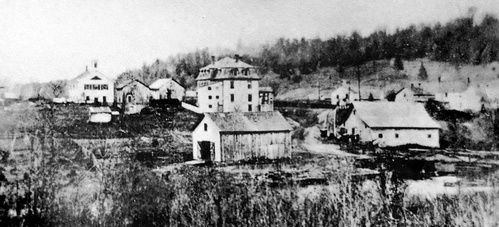 This photograph, dated 1880, is clearer, but otherwise identical to the one published in the Watertown Daily Times, 1948. (Courtesy of Sarah Blanchet) Watertown Daily Times, 1948
This photograph, dated 1880, is clearer, but otherwise identical to the one published in the Watertown Daily Times, 1948. (Courtesy of Sarah Blanchet) Watertown Daily Times, 1948
OLDEST PICTURE — Believed the oldest picture of Saranac Lake in existence, the above photograph, taken by George Baldwin, recently appeared in a display at the Adirondack National Bank and Trust company and was loaned by the E. L. Gray and company.
With his tripod set up in what was then marshes, Photographer Baldwin focused on the Berkeley Hotel, then the largest building in the village. Four-stories high when it was built, a fire on Jan. 1, 1924, leveled the top floor of the building to such an extent that when repairs were made builders placed the new roof over the third floor and eliminated the fourth story.
Directly in front of the Berkeley Hotel is a barn like structure, which at one time housed an undertaker. On that site today stands the George L. Starks building and to the left of it today is Woodruff street. Across from the barn is an early livery stable which was demolished shortly after the picture was taken. On the right side of the photograph can be seen a crude wooden bridge that extended Broadway over the Saranac river. Today that bridge is a structure in stone and steel.
On the extreme upper left side of the picture is the famous "Manning House" which still stands and has become the Saranac Lake Study and Craft Guild. The white church-like building to the right of the Manning House is the original school house. This building was moved when a new building was constructed and set many feet behind its original site. It still stands and is now 15 Academy street.
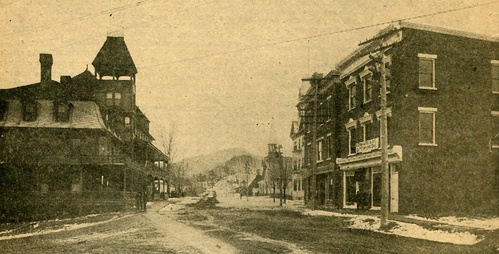 Watertown Daily Times, 1938 Watertown Daily Times, 1938
Watertown Daily Times, 1938 Watertown Daily Times, 1938
Berkley Square is shown in the above picture taken about 1895. The old Berkeley hotel and the original Leonard and Company store can be seen. The first wooden sidewalks used in the village can be seen in the foreground. An addition was built later to the Leonard store to make it into the present structure. Mount Baker is shown in the background of the picture. Part of the old school building, which was torn down in 1923, is shown in the picture. The Hotel Saranac now stands on the site of the school. The Kennedy building, adjourning Leonard's, is practically the same today as it was when the picture was taken.
Lake Placid News, May 18, 1945
SELL BERKELEY HOTEL AT SARANAC LAKE
The historic Berkeley hotel in Saranac Lake, built about 1877 by Charles M. Gray 6 has been sold to Edward M. Bratter, New York city lawyer.
Bratter has been a seasonal resident of Saranac Lake for nearly a half century. The purchase was made from Mrs. Walter Sagendorf.
The hotel was almost destroyed by fire on New Year's day in 1925. Sagendorf rebuilt it into an apartment and rooming hotel. Today it contains eight apartments, seven stores and several offices, as well as a dozen or more rooms.
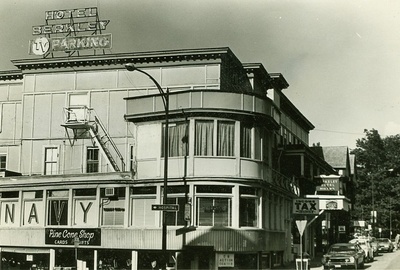 Berkeley House, September 9, 1977. Note the misspelled sign. Courtesy of John Van Anden
Berkeley House, September 9, 1977. Note the misspelled sign. Courtesy of John Van Anden 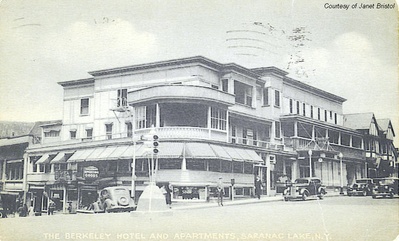 Berkeley House after the 1925 fire— notice the missing top floor
Berkeley House after the 1925 fire— notice the missing top floor
Essex County Republican, June 1, 1945
Historic Berkeley Hotel Saranac L. Sold To Lawyer
The historic Berkeley hotel built about 1877 by Charles M. Gray, at Saranac Lake, has been sold to Edward M. Bratter, New York City lawyer, Thomas P. Ward, realtor and agent in the transaction, has announced.
Bratter is a member of the law firm of Marshall Seligson & Bratter of New York City and has been a summer resident and seasonal resident of Saranac Lake for nearly a half century. The purchase was made from Mrs. Walter Sagendorf.
Through the Ward agency, the new owner has announced that improvements and renovations to modernize the building are to be made as soon as war conditions permit.
The deal is one of the largest transactions that has taken place in Saranac Lake's real estate boom that has resulted in the sale of numerous businesses, many business blocks and a large number of dwellings.
The builder of the Berkeley was the father of Lee and Bertrand Gray, Saranac Lake business men who lost the three-story frame hostelry when Milo B. Miller foreclosed his mortgage. The property was then leased to R. E. Woodruff, a carpenter and builder, who has constructed many buildings including the Episcopal Church" in Saranac Lake. Several other lessors held the hotel until it was sold to Dennison and Streeter in 1882. Dennison added a left wing to its northern side and operated it until 1931 [sic Apparently a typographical error for 1913; see item from Chateaugay Record, above], when it was sold to the late Walter Sagendorf.
The hotel was almost destroyed by fire on New Year's Day in 1925. Sagendorf rebuilt it into an apartment and rooming hotel. Today it contains eight apartments, seven stores and several offices, as well as a dozen or more rooms. No sale price in the deal was announced. The new owner will take possession June 1.
Adirondack Daily Enterprise, January 12, 1981
Fire destroys historic Berkeley Hotel
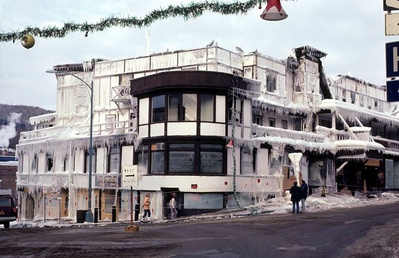 Coated with ice after the 1981 fire. Courtesy of Jack Drury.
Coated with ice after the 1981 fire. Courtesy of Jack Drury.
22 people left homeless; 15 businesses destroyed
Sub-zero temperatures hamper firefighting efforts
BY E.J. CONZOLA II
SARANAC LAKE - Seventy-nine firemen from four companies battled flames and sub-zero temperatures in a vain effort to save the historic Berkeley Hotel Saturday night.
The firemen braved temperatures which reached 26 below zero in a futile attempt to save the 104 year-old, mostly wooden structure. The wind chill factor through much of the night was minus 40 or colder.
Twenty-two residents of the hotel were left homeless by the blaze. Six persons had to be rescued by snorkel' truck from the third floor roof and one was removed by ladder from the second story.
The fire apparently began in the basement of the building near the main entranceway, according to Saranac Lake Fire Chief John Bombard. Flames spread through the walls for several hours, making it difficult for firemen to pinpoint the center of the blaze. Flames broke through the roof at around 8 p.m.
The cause of the fire has not yet been determined!'Bombard said. No one had been inside the building as of this morning, but firemen were hopeful that an investigation into the cause of the blaze could begin today.
There were reports that salamanders 7 were being used to heat frozen pipes in the cellar the night of the fire.
Firemen were called to the scene at 6:14 p.m. Fire Driver Kent Robinson, the first to enter the building, began evacuation procedures with the aid of an air pack. Heavy smoke forced firemen to work with the oxygen units most of the night.
 Adirondack Enterprise, October 1, 1915
Adirondack Enterprise, October 1, 1915
A thick smell of smoke
Robinson said that when he first entered the building, there was a thick smell of smoke in the air. He said he noted scorched areas on the second floor walls, and that the walls were hot to the touch.
Bombard said that efforts to contain the fire were hampered by its location. Firemen were forced to cut through the walls to get at the fire, and Bombard said that by the time one fire center had been located and dealt with, the flames had spread through the walls to adjoining areas of the building.
Although the upper two floors were almost completely gutted by the blaze, the first floor suffered little fire damage. Bombard said that the internal sprinkler system, which came on immediately, prevented flames from spreading throughout the lower part of the structure.
However, the first floor was still almost totally destroyed by smoke and water damage. Most the 15 businesses housed in the hotel lost everything.
Volunteers help with effort
Only Noonmark Natural Foods was able to save some of its inventory. Thanks to the volunteer efforts of a number of friends and by-standers, store owners Glenn and Sue Arnold were able to strip their store before smoke and water could inflict heavy damages. However, Mrs. Arnold estimated that they lost close to $15,000 worth of merchandise and equipment in the blaze.
Other store owners were not so lucky. With the exception of Metropolitan Oil, which was able to save its records, nothing else was saved from the hotel. Phil Daniels, owner of the Pine Cone Shop, helped the Arnolds strip their store. Heavy water damage had already made salvage operations in his shop impossible, and the weight of the water contributed to the collapse of the ceiling of his store, which occurred around 7:30 p.m.
Firemen were still on the scene Sunday afternoon, as small fires kept burning in the shell of the structure. Firemen returned to the station nearly 24 hours after first being called out, but left hoses running at the site to insure that a second flare-up did not occur.
Residents lodged temporarily
Thirteen of the building's 22 residents were being housed across the street at the Hotel Saranac until more permanent arrangements could be made. Others were being lodged in private homes throughout the village.
Among those left homeless was the 23-year old owner of the hotel, John McClain. McClain had purchased the property in January of 1978 for $39,012 and had invested heavily prior to the 1980 Winter Olympics for renovations which included the installation of the sprinkler system and other fire safety features.
Only minor injuries were reported, in spite of the cold and heavy smoke which surrounded the fire. Fireman Ed White suffered a sprained thumb and Fireman Mitchell Smith suffered a sprained ankle. Three residents of the hotel also suffered smoke inhalation. Two were treated and released from the General Hospital of Saranac Lake, the third remained hospitalized over night.
Seventy-nine firemen from Saranac Lake, Bloomingdale, Paul Smiths Gabriels, and Lake Placid responded to the alarm.
The historic hotel was the scene of another fire in the 1920's. That fire destroyed the lower in the front of the structure and much of the third, floor. but the main part of the building was saved. The third floor was later rebuilt.
No estimate of the damage was available this morning.
As the fire burned, a number of local businesses opened their doors to firefighters and by-standers, offering donations of coffee and food, and warm places as a respite from the chilling weather.
From Stephen Chalmers, "The Penny Piper of Saranac," about Robert Louis Stevenson:
It was planned to give the [St. Luke’s] church benefit supper at the old Berkeley Inn in the village. On the promise of Stevenson’s mother that she would induce her son—somehow—to be present, the church ladies sold every available seat, except one—that reserved for the lion of the occasion. Despite the elder Mrs. Stevenson’s assurances, up to the last moment Robert Louis refused to be a party to the party. “Good Heavens!” he exclaimed. “They might ask me to make a speech!”
In the end the ladies had to kidnap him bodily. At first he was silent, even morose, when he took his seat at the supper table in the old inn; but suddenly the humor of the situation struck him and his chameleon-like mood changed color. He threw himself into the affair with a spirit than was more Stevensonian than churchlike. He not only proceeded to enjoy himself, but helped to make that church supper a memorable success; and before he escorted his mother home, he insisted upon making a speech.
All record of that speech is lost—more’s the pity! Mrs. Martin does not remember just what he said, but –
“It was—like him.”
See also:
Comments
Footnotes
1. Per Phillip L. Gallos. However, the Registration Form for the National Register of Historic Places gives the builder as Milo Miller and the year as 1876. Alfred L. Donaldson indicates that Miller held a mortgage on the property, and foreclosed on it the year after it was built, which may account for the error. Frederick Seaver gives Gray as the builder, but gives the date as 1977, likely a typographical error for 1877.
2. Seaver, Frederick J., Historical Sketches of Franklin County, Albany, NY: J. B. Lyon Co., 1918
3. Adirondack Daily Enterprise, June 14, 2002. Note: George Berkeley is also the name of a proprietor of the Riverside Inn who was killed in 1888 by guide Charles Brown.
4. Adirondack Daily Enterprise, December 8, 1990 "Presidents, from first to last, in the Adirondacks", John J. Duquette
5. For more information on this photograph and caption, see Old Saranac Lake photographs
6. The initial is wrong: it should be Charles F. Gray
7. From Wikipedia: "A salamander is a culinary broiler characterized by very high temperature overhead infrared heating elements ... used primarily in professional kitchens for ... broiling... Salamanders are generally similar to an oven without a front door, with the heating elements at the top.



